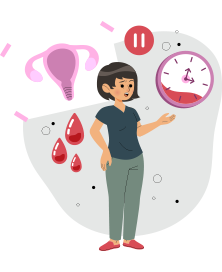Maternal Health Issues
Haemorrhage

About
Haemorrhage refers to abnormal and excessive bleeding that can occur internally or externally due to a variety of reasons, such as trauma, surgery, or underlying medical conditions. It can be life-threatening if left untreated.

Symptoms
You may experience some or all of the below symptoms if you are transitioning to menopause
- Rapid heartbeat
- Pale skin
- Low blood pressure
- Dizziness
- Weakness
- Shortness of breath
- Abdominal pain

Risks
Haemorrhage can be associated with a variety of risks, including anaemia, shock, organ damage, and even death. Certain medical conditions or medications can increase the risk of haemorrhage, and individuals who have experienced haemorrhage in the past may be more likely to experience it again.

Routine Checkups
Regular medical checkups can help identify underlying medical conditions that may increase the risk of haemorrhage. Individuals with a history of bleeding disorders, high blood pressure, or other medical conditions may require more frequent monitoring to detect potential issues early.

Treatment
Treatment for haemorrhage involves stopping the bleeding and addressing the underlying cause. This can include surgical intervention, blood transfusions, medications, or other therapies. In severe cases, emergency care may be necessary to stabilize the patient.



